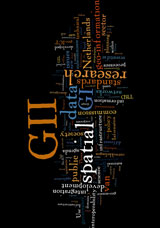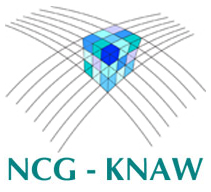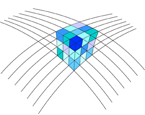
Download the pdf-file of the Research plan (180 kB) >>
Mission and tasks of the commission Geo-Information Infrastructure
Mission
The mission of the commission Geo-Information Infrastructure (NCG-GII) is to contribute to the long term development of the Geo-Information Infrastructure (GII).
Positioning and interpretation
The NCG-GII is a commission of the NCG (Nederlandse Commissie voor Geodesie - Netherlands Geodetic Commission) focussing on the geo-information infrastructure. Within this subject, the commission has an independent position with a focus on initiation, coordination and evaluation of mid-term and long-term academic research and the research of non-academic parties.
For an optimal contribution to society the commission aims at a composition that consists of members coming from government, business parties and scientific organisations.
With respect to the development of the GII the commission aims at both technical, organisational, political, legal, economical and user aspects of the GII.
The commission gives substance to its' mission by regular meetings, consultation and by elaborating and maintaining a research agenda.
Tasks
The following tasks of the commission are defined:
- Providing both asked as unasked advice;
- Initiate, coordinate and evaluate research and ;
- Propagate results of its’ advice and research.
Research setting
State of the art in GI Science
The term geographical information science (GIScience) was introduced by Michael Goodchild in 1992 in his landmark article in the International Journal of Geographical Information Systems (1). In this paper the scope and foundation of a scientific field that covers a broad range of topics such as spatial data capture, data structures, spatial statistics, data modelling and analysis, display and institutional issues was described. Since then the field has developed into a robust scientific dis-cipline with specialized international conferences, scientific journals, research agendas and own chairs at universities worldwide. The central theme of the field is the handing of spatial data in all aspects. This can be researched as a topic on its own or in combination with application domains. Since 1992 various research agenda's for geographical information science were formu-lated, both national as international. An early influential agenda was proposed by the NCGIA (National Center for Geographic Information and Analysis) in the USA. Within this agenda vari-ous research challenges such as the theories of spatial data, spatial data quality, spatial cognition, data structures and spatial data modelling were formulated. Over the years research agendas and activities have changed. The following major trends can be observed.
(1) M.F. Goodchild, 1992. Geographical information science. Int. J. Geographical Information systems 6: 31-45.
From practice to theory
The early GIScience questions were mainly derived from application domains and rather technical in nature, but over the years an own GI body of knowledge starts to develop. Current GI theoretical questions deal with spatial scaling, the space-time description of spatial phenomena and processes, spatial perception of humans, spatial ontology's, etc.
From GI application to geo-information infrastructure
A few decades ago a GI-application was a combination of data and a software system for the support of a specific question. Since the beginning of this century a world-wide paradigm shift took place. Spatial data is increasingly organized in the form of local, national en international infrastructures (GII) that support many actual and potential applications. This has resulted in GII research (2) which focuses on spatial data and technical interoperability, standards, semantic in-teroperability, policy, organization issues, assessment frameworks, etc.
(2) Y. Georgiadou, S. K. Puri and S. Sahay, 2005. Towards a potential research agenda to guide the implementation of Spatial Data Infrastructures—A case study from India. Int. J. Geographical Information science.19:1113–1130.
From spatial data structuring to meaningful spatial data integration
Data structures and the efficient algorithms for storing and retrieving data was a key research activity in the eighties and the nineties of the previous century. Now the emphasis has shifted towards meaningful exchange and integration of spatial data. The concept of spatial data ontolo-gies as a potential solution to this challenge is emerging research topic world-wide.
From mapping to dynamic real-time spatial data collection and visualization
The 2D static map was and probably still is the dominant way of obtaining and presenting geo-information. Fast developments in sensor technology and visualization techniques induce a shift to dynamic real-time spatial data collection and the direct use of these data in process models and in visualizations. Research on how these new approaches can be used to obtain reliable information on spatial phenomena and how these data can be used by public, governments and business is still in its infancy (3).
(3) Max Craglia, Michael F. Goodchild, Alessandro Annoni, Gilberto Camara, Michael Gould, Werner Kuhn, David Mark, Ian Masser, David Maguire, Steve Liang, Ed Parsons, 2008. Next-Generation Digital Earth: A position paper from the Vespucci Initiative for the Advancement of Geographic Information Science. International Journal of Spatial Data Infrastructures Research. 3: 146-167.
From technological to socio-technical
Originally GI research was quite technical in nature, however with the strong diffusion of the GI technology in society it is also becoming a research area for policy, organization and law re-searchers. Also the GII societal setting has become a research topic. From a mainly technical research field it has developed into a socio-technical research field. Appropriate scientific meth-ods that can be applied for this new setting need to be developed and tested. From a few application areas to many disciplines in society One of the major developments the last 20 years is probably the strong increase in disciplines where GI is used. The classical domains for GI are agriculture, spatial planning, environment, land registration and transportation. Now, GI has found its way into almost all disciplines in our society, ranging from history to medicine and banking and tourism. This has resulted is a strong demand for 'with GI' research. A key question is how can GI concepts and technologies be ben-eficial to the discipline.
In summary we can say that the research agenda on GIScience has strongly developed over the last two decades with mainly unresolved questions and challenges ahead of us with a clear niche for GII research.
Scope of commision GII
The NCC commission GII focuses on 7 research themes. The selection of the themes is the result of extensive internal discussions and a reflection on international developments. The research themes are formulated in such a way that they a) cover the GII field, b) are researchable topics and c) are recognizable as issues for the outside world. The following topics are formulated:
- Theory & methods;
- Use & usability;
- Governance;
- Service Architecture;
- Application of standards and interoperability;
- Connecting to the information infrastructure (II);
- Sensor networks.
Theory & methods
The last few years research on the development of Geo-Information Infrastructures (GII) has developed rapidly within the domain of GIScience. It is clear that within this emerging scientific area many new definitions are proposed and systems developed. This new field needs accurate description regarding technical, organisational and political aspects. Also, there is a strong need for scientific elucidation on the design, development and use of GII's and its coherence.
Use & usability
GII's have shown a strong development over the past 10 years from the 'supply' side. Local, regional, national and international GII's were established. Although most GII's are certainly used, there is still little insight in the nature of its use, the role they play in the application domains, and the satisfaction of the users with the offered services. For a healthy development of GII it is essential to have more insight in the use and usability aspects.
Governance
The governance of information infrastructures for more than one organization is dependent on how individual organizations contribute or benefit from the infrastructure elements. Hence, governance should take into account how multiple organizations coordinate their activities, and which coordination instruments are effective or not. Given the different roles that public and private sector have in society, the coordination objectives and instruments are different in the public sector as compared to the private/corporate sector. As a result, the governance of GIIs emerging within the public sector is likely to be different from those emerging through the private sector. More insight is needed in existing governance structures of GII and its effect on their functioning.
Service Architecture
The supporting technologies and the associated services are the backbone of the GII develop-ment and implementation. Most (if not all) of the technologies are not designed in the Nether-lands. We are just using what is internationally available. However for the implementation of the Dutch GII we still have a choice. Are we going to use or even stimulate a particular technology? In order to make the appropriate decisions early experimentation and evaluation of emerging technologies is essential.
Application of standards and interoperability within GII
The infrastructure perspective on GII emphasizes that the social and technical issues are not separable. Standards are inherently social/political. Interoperability is also a key issue in effective governance and the use of geo-information: it removes barriers in innovation processes and prevents customer lock-in, license issues, etc. The selection and maintenance of standards requires both a dialogue as practical experimentation. For the more technology oriented standards we are more in an evaluation and adaptation position, while for the more data and data-service oriented standards we also have a design role to play.
Connecting to the information infrastructure
The overall goal of this commission is to contribute to the long term development of the GII. However, the GII itself is an integrated part of an overall Information Infrastructure and, therefore, developments in both information infrastructures will strongly influence each other. The other way around, the development of the internet and publicly available mapping applications such as Google Earth or Bing Maps has had a tremendous impact on the geo-information society. After these years of mainly internal GII development it is now time to look externally and redefine the relationships between the GII and the rest of the world!
Sensor networks
GII's are not static, but evolve over time both in their socio-technical aspects as in their data and service content. An interesting development is the amalgamation of GII's and sensor networks, including human sensors. Sensor networks are able to capture spatial- and temporal phenomena real-time and allow organizations to react on events and take actions. Senor networks, both for-mal and informal, are present in a variety of technical implementations and user communities. A synergy between these is beneficial for both GII as well as (human) sensor network development.
Research questions
The research questions for the selected themes are:
Theory & methods
- What are the theoretical foundations of GII?
- Are there existing theories that can support us to understand the nature of GII's?
- Can theories help to forecast GII developments?
- What is the influence of a theoretical notion of GII in its practical implementation?
Use & usability
- How do we measure and assess the use of GII's?
- What are stimulating and limiting factors for GII use?
- Are there regional differences in the use of GII's and can these difference be explained?
- What are current and future user requirements for GII's?
Governance
- What are the current governance models for GII's?
- Can the existing governance models for GIIs be explained from the specific socio-technical conditions?
- What are the pros and cons of the governance models in use?
- How can we design and evaluate governance models to operationalise the GII as a sustainable infrastructure?
Service architecture
- What are important technological developments for GII?
- What are the most promising technologies for the Dutch GII?
- How can we apply semantic models (ontology) for spatial data integration?
- How can we develop 'intelligent' GII services?
Application of standards and interoperability
- Is functionality appropriate and/or missing in current interoperability standards?
- What is the level of interoperability in current GII products and services?
- What are the requirements of integrated geo-sensor networks towards standards and are current standards for sensor networks applicable?
- How can we implement standards and improve their acceptance by stakeholders?
Connecting to the Information Infrastructure (II)
- What are the major connection points between the GII and the II (economic, social, political)?
- Are there generic problems which impede the GII to support and penetrate into other domains of the overall II?
- How can we use spatial data to more effectively disseminate and/or analyze 'non-spatial' data?
- What current and future developments in information infrastructures will impact the GII?
Geo-sensor networks
- How can we design a geo-sensor networks for monitoring of spatial dynamic processes?
- How can we extract information from informal geo-sensor networks?
- How can we integrate real-time sensor-data in the GII?
- How to handle large sensor-based datasets?














